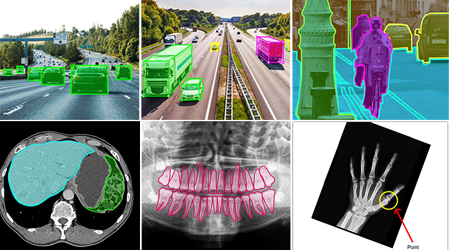Understanding Computer Vision: Applications, Working, Benefits & Drawbacks
 By Anolytics | 09 February, 2024 in Image Annotation | 3 mins read
By Anolytics | 09 February, 2024 in Image Annotation | 3 mins read

AI Computer Vision utilizes machine learning for identifying all the user interface components on the computer screen. It doesn’t depend on selectors but an anchoring system to tie it all together. In order to locate elements on the screen, AI Computer Vision carries out element detection (on machine learning server) and a text (OCR) detection. It merges the two to gain complete understanding of the user interface.
It permits the AI models to quickly consume, absorb and glean from vast quantities of labeled and unlabeled visual data. This gives computer vision-enabled computers the capability to recognize different features, patterns and relationships in videos and graphics.
Machine learning utilizes huge quantities of training datasets to learn about patterns. Machine learning algorithms spot features, characteristics or objects inside the most complicated images. For instance, it can be used for identifying the nose in a human face and identifying it as one. It can also be used for differentiating one part of an image from another.
Computer Vision: Key Applications

1. Medical imaging: AI algorithms assist medical professionals in analyzing different types of imaging documents - X-rays, MRI scans, etc. This further assists in anomaly detection and problems for enhanced diagnoses.
2. Autonomous vehicles: Computer vision aids autonomous vehicles in interpreting their surroundings since these vehicles are not manned by human drivers. To prevent disasters, objects and surroundings needs to be identified accurately.
3. Agriculture: Computer vision can be used to assess crop quality, soil condition, disease detection that can affect plants. The technology assists farmers as they can use it for optimizing crop yields and limit resource wastage.
4. Retail: Computer vision is used by retail companies for optimizing efficiency of supply chain and enhancing total productivity. It is used for enhancing customer experience and limiting churn. The technology is used by big retailers for identifying and replenishing empty shelves and recommending products to customers on the basis of their browsing or purchase behavior.
5. Surveillance: Crime authorities have been utilizing computer vision for monitoring public places like railway stations, museums, etc. for quickly identifying suspicious behavior or movement of criminals. With improvement in technology, it can assist in crime prevention.
Computer Vision: How it Works
Computer vision requires huge quantity of information. Data analyses is done repeatedly for the system to distinguish objects and spot visuals. The two key techniques used for achieving this goal are; deep learning and convolutional neural network. By using pre-programmed algorithmic frameworks, machine learning system can instantly learn how to interpret visual data.
Computer vision can be compared to a jigsaw puzzle where all the pieces need to be combined together to form an image. In the same manner, neural networks function within computer vision. A series of filtering and actions enable computers to combine all parts of the image and then think on its own. But the computer is not simply handed a puzzle of an image but fed with several images which train them to recognize particular objects.
Computer Vision: Benefits for Companies
Human intervention is not required for automating several tasks using computer vision. It offers organizations with several benefits:-
1. Quick and simple process: Repetitive and monotonous tasks can be executed quickly through computer vision systems. This in turn makes the work of humans simple.
2. Enhanced products and services: Well-trained computer vision systems incur zero errors resulting in quick delivery of qualitative products and services.
3. Reduction in costs: Companies need not invest money in setting right flawed processes since computer vision leaves no scope for flawed products and services.
Computer Vision: Drawbacks for Companies
As with any technology, computer vision too has certain limitations which are outlined below.
1. Specialists are required: Companies require highly trained professionals with in-depth knowledge of AI, machine learning and deep learning for training computer vision systems.
2. Regular monitoring is required: Companies must hire a dedicated team of specialists for troubleshooting and evaluating computer vision systems which can be very costly.
Hence, computer vision is no doubt an emerging technology like artificial intelligence, but it has its inherent drawbacks. These are privacy and confidentiality breach, consumption of mass data and the way it's being utilized and finally, how hackers with malintentions are creating deep fakes which can confuse computer vision into flagging them.
please contact our expert.
Talk to an Expert →
You might be interested

- Image Annotation 04 Jul, 2019
A complete solution for detecting objects using AI and machine learning in images
AI and machine learning are completely relying on training data to develop a model for real-life application. The traini
Read More →
- Image Annotation 18 May, 2021
Why pixel accuracy is the future of the image annotation for Machine Learning?
Training of drones, autonomous vehicles, and other computer-vision based models needs annotated images and videos so tha
Read More →
- Image Annotation 06 May, 2022
The value of image annotation services for AI and machine learning
Identifying, getting, characterizing, and interpreting findings from digital pictures or videos is an image annotation.
Read More →